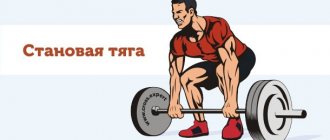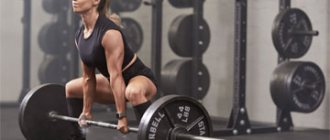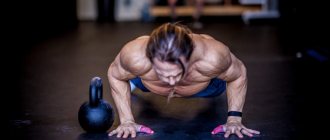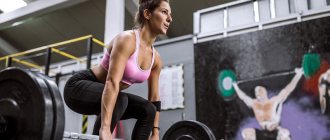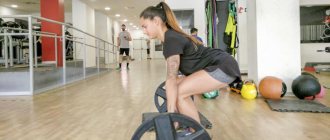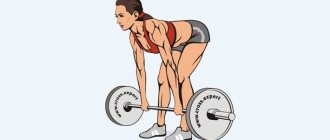Our two previous articles, “Barbell Squats: Standards” and “Bench Press: Standards,” turned out to be surprisingly popular. Therefore, we decided to complete this series of articles with material about deadlift standards . Thus, we will consider the standards for the entire competitive trio of exercises in powerlifting (press, deadlift, squat).
We have already mentioned that there are no uniform standards in powerlifting. Regulations vary depending on the federation, the gender of the athletes, doping control and equipment.
In this article we will try to collect as many different standards as possible. To quickly switch to the federation and type of regulation you are interested in, you can use the links from the table of contents of the article.
The emergence of the deadlift as a competitive exercise
At all times, strong people loved to demonstrate their abilities to the public, especially in lifting weights from the ground. Everyone has heard the legend of Milo of Croton, who from childhood carried a calf on his shoulders, and while the bull grew, the young man became stronger. Let's remember the circus strongmen who impressed the audience with incredible tricks. For example, Ivan Chekunov lifted an anvil weighing 560 kg in 1893. But as a competitive exercise, the deadlift began to be used only in 1947.
The first powerlifting competitions were organized by Leo Stern in the USA. This sport received official recognition in 1964. The deadlift is a shortened version of the weightlifting movement, the barbell push. The bar should be raised to approximately knee level. Because of this, powerlifters are able to deadlift heavier weights than weightlifters.
How to correctly calculate the working weight in an exercise?
All exercises that athletes perform in gyms are usually divided into two main classes, isolating (single-joint) and basic (multi-joint), that is, they involve two or more joints when performing a working movement.
It is very important to choose the right working weight in basic exercises, because only they can significantly influence the growth of strength indicators and muscle mass (notably, they can also cause very serious injury to the athlete, so it is important not only to select the right weight during training, but and study thoroughly the technique of performing these exercises).
The basis for calculating working weight should be percentages (%) of the maximum possible weight that you can lift in a given specific exercise. For example, there are concepts that are closely related to the training program in the gym, such as light, medium, and heavy training. So, light training means the working weight in the exercise is 60-65% of the maximum, medium 70-75%, and heavy 80-85%.
Calculation of working weight in an exercise
Let us consider below, using a specific example, the calculation of the working weight when performing a barbell bench press while lying on a horizontal bench.
An example of calculating the working weight in the bench press
Suppose we found out that our maximum result in the barbell chest press is 90 kg , which means that the working weight, when converted to training taking into account the load, will look like this:
- if we have an easy workout: 90 * 0.6 (0.65) = 54 or 58.5 kg = 55-60 kg
- if the average workout: 90 * 0.7 (0.75) = 63 or 67.5 kg = 65-70 kg
- if hard training: 90 * 0.8 (0.85) = 72 or 76.5 kg = 75 kg
We round up to a whole number or a larger number, then during the training itself you can correct it (not important). You can see how to combine training with light, medium and heavy loads in the mass training program. As a rule, if an exercise is performed for 6 repetitions, then it is a heavy training, if for 8 - medium , if for 12 - easy .
As for calculating the working weight in isolating exercises, for example, dumbbell curls, dumbbell flyes on a horizontal bench, crossover, lying leg curls, and so on, there is no strict calculation, here you should focus more on your own sensations , taking into account the load you want to achieve and the number of repetitions you want to perform.
An example of calculating the working weight in the bench press
If you train hard, then at the end it should be really hard (but don’t push yourself to the point of complete failure, this is an extra, big stress for the body, after which it will need to be given a lot of time to recover ), if it’s average, then it shouldn’t be very hard, but it’s not easy either, if the load is light, then the exercise should be performed without unnecessary, excessive effort, in compliance with ideal technique .
Deadlift Limitations
This exercise, in technical terms, is the simplest of the powerlifting “troika”. But, at the same time, due to the significant axial pressure on the spine, it is very traumatic. Therefore, traction is not recommended for people who have problems with the spine (scoliosis, lordosis, kyphosis), injuries to the back muscles, neuralgia in the cervical, thoracic or lumbar regions. It is also not advisable to pull for those who have sore knee or elbow joints, problems with the cardiovascular system, or high blood pressure.
Types of rods and load distribution
There are several options for performing this exercise. Powerlifting uses the “classic” deadlift and the “sumo” style. In bodybuilding and fitness, straight leg deadlifts, “Romanian” deadlifts, and all these movements are more often used, but with dumbbells or kettlebells instead of a barbell. In all of the above exercises, the legs, abs, back and partly the arms, shoulders, and neck are loaded. In the classic deadlift, most of the load falls on the trapezius, latissimus muscles, back extensors, and quadriceps. The sumo style uses the legs more. Namely: adductor, gluteal muscles. “Romanian” deadlifts and straight legs are used to shift the load to the hamstring area.
If you have no contraindications to performing deadlifts, but you don’t know which variety to choose, take a look at their advantages and disadvantages and make the right choice. It’s worth clarifying right away that “basic” exercises, that is, those that increase strength and overall mass, are considered deadlifts in the classical or “sumo” styles. The remaining types are used as auxiliary movements, to increase the volume of a specific muscle, when working on relief and to adjust proportions.
Benefits of inclusion in the training process
The deadlift as a target exercise has a number of positive aspects. What are the main advantages of such strength training:
- Deadlift is the basis in the training work of every bodybuilder. The benefit of the exercise is that it can simultaneously develop several muscle groups in a complex: the legs, buttocks, and back.
- This exercise makes it possible to significantly increase your strength growth rates. Simultaneously with the improvement of strength qualities, there is a parallel increase in muscle mass.
- Traction can influence the elimination of certain problems arising from back pain.
Another interesting fact is that at the time of working out the described exercise, the body uses almost 70% of the muscles of the entire body. This is why it is considered holistic and energy-intensive. And that's why it is included in the basis of any functional training.
Differences between classic deadlift and sumo deadlift
Their main difference is in the starting position. In the “classic” you place your feet shoulder-width apart, toes pointing forward, and hands along the outer thighs. In sumo, the legs are spread the entire length of the bar between the plates, the toes and knees are turned outward by 160-175°, the hands are located slightly narrower than the shoulders. The choice of the optimal option for you depends on several factors: the ratio of the length of the levers (torso, hips, legs, hands), the flexibility of the hip joints, the ratio of the strength of the back and leg muscles. If the last two parameters can be developed and improved, then you will have to come to terms with the first.
If you have long arms and short legs, then it is not recommended for you to pull in the “classic” manner, since you will not be able to take the correct starting position for a good “stretch”. This also applies to tall athletes. Athletes of short stature predominantly pull “classically”, but if stretching allows them, then from the point of view of geometry, it is more profitable for them to pull in the “sumo” style. Since in this case the trajectory of movement is reduced to 40%. As for the strength of muscle groups, if your back is much stronger than your legs, your choice is “classic”. In any case, try training for at least two months in each style, and only then choose the more preferable one.
Deadlift on straight legs
Another frequently used option among analogues of the classic exercise is the deadlift. The correct technique for the classic deadlift is in many ways similar to it, but there is still a difference. What is the difference between these two varieties of the same exercise:
- Firstly, the amplitude of movement. The classic involves pulling from the floor, deadlifting is carried out from the level of the shin.
- Secondly, the position of the legs. In the classics, the legs are rhythmically bent and extended, and the deadlift is carried out in a position with straight legs.
- Thirdly, the emphasis is on the load. The classic exercise transfers the entire load to the back muscle corset, while the deadlift is aimed at pumping the gluteal muscles and the back of the thigh.
- Fourthly, the recommended load. A purely masculine exercise, the traditional deadlift is based on a heavy force load. Deadlifts are performed more often at medium to low intensity.
Thus, girls more often use deadlifts in their training practice. This is explained by the great interest of the fair half in modeling beautiful muscle relief in the gluteal and thigh areas.
Detailed analysis of deadlift technique
The entire movement, in both styles, can be divided into three stages:
The first phase is approaching the barbell and taking the starting position.
The position of the legs and the position of the hands were discussed above. As for the grip, many athletes use an “overhand grip,” when one hand grips the bar from above and the other from below. This method significantly reduces the torque of the bar around its axis and prevents the bar from slipping out of your hands. You can use the “lock grip” from the arsenal of weightlifters, when the thumb clasps the bar and the rest cover it on top. Holding the barbell, keeping your back straight, sit your pelvis until the thigh muscles are maximally stretched. Shoulders should be pulled back and slightly lowered, chest pushed forward, gaze directed upward.
The second phase is removing the barbell from the platform and raising it to its final position.
You need to lift the bar powerfully, but smoothly, as if a train were moving. Under no circumstances should you jerk the bar. In this case, the starting position is distorted, the back “breaks,” and the pelvis rises too early. Ideally, you should try to push the floor with your feet, so your legs will be involved in the work as much as possible. The bar should always be as close to your legs as possible. When passing the knees, the back is actively involved in the work. At the end of the movement, you should roll your shoulders back a little. You should not jerk your trapezius upwards or bend your lower back too much, this uses up excess energy and can lead to injury.
The third phase is fixing the position and returning the bar to the platform. Once your knees are straight and your shoulders are back, it is important not to relax or let go of the barbell. Next, you lower the barbell onto the platform in reverse order. If you use the sumo style, be careful not to let the plates fall on your toes.
Classic
How to do classic deadlifts? Many beginners ask a similar question, because this is the exercise most often used by men, which is unconditionally included in their training. Especially in cases where you want to quickly and effectively achieve real progress in muscle growth.
The correct deadlift technique and its classic implementation consists of the following actions:
- Take an empty bar to master the technique, stand in front of it and place your feet parallel to each other at a distance slightly wider than your shoulders.
- Straighten your back, move your pelvis back, leaving your torso in a position of natural deflection in the lower back. Do not round your back, keep your neck in a position that continues the direction of your back, do not lower it down.
- From the starting position, tilt your body forward, while moving your pelvis back. Make sure your shoulders extend slightly forward beyond your shins. You will feel the need to bend your knees slightly, and you do.
- Adjust the angle of your body to 45 degrees.
- Lower your arms down: with the correct tilt, they will be at the same level with the front of your shins.
- In this position, you have a very short distance to the bar: you sit down to take it, but do not lean either back or forward. Your main goal should be to move your shoulders strictly vertically up and down while performing the exercise.
- Take the bar with the correct grip, namely with your palms facing towards you.
- Slowly and carefully straighten your legs, and then straighten your back. When you train with weights, you won't need to go as low because the weights on the bar will keep it elevated. And then you will need to approach the barbell so that the bar rests on your shin, and from this position you will need to lift the barbell.
- When you are completely straight, bring your shoulder blades together as much as possible.
- Go downhill again: to do this, first bend over and bend your back to 45 degrees, and only then bend your legs. Be sure to watch your shoulders: they should be exactly above the bar, and the bar, in turn, should seem to slide up and down your legs.
To get into the rhythm and get used to the technique, you need to do several repetitions as a warm-up: cleanly with the bar, and only then work with weights. When you lower yourself with the barbell, work on sets: there should be about 3-4 of them in an amount of 6-8 repetitions. Don’t immediately chase heavy weights, build them up gradually.
Selecting Working Weights and Frequency of Deadlift Training
Remember, you shouldn’t rush and go straight to heavy weights. You always have to work on your technique first. If you perform the movement technically correctly, the weight on the bar will increase rapidly. You can even start with an empty bar, gradually increasing the number of weights on the bar. The number of repetitions in the first months of classes can be increased to 10, in 5–6 approaches. This needs to be done to improve muscle coordination so that the movement is practiced to the point of automaticity.
Once you have developed good technique, you can increase the weight so much that you can do 5 reps in 4 to 5 sets. If your goal is to develop strength, you should cycle the loads, periodically weighting the barbell so that you can handle 2 repetitions in 2-3 sets. Because deadlifting is a difficult exercise, where a large number of muscle groups are loaded and it takes a lot of time to recover. It is recommended to pull once a week, and when the working weights exceed the value of two of your own, pulling training can be done twice a month or 2 times every three weeks.
Basic technical nuances
There are a number of technical nuances that are important to observe. And this does not depend on the type of traction chosen. What is important to remember when performing the exercise:
- Do not lift your heels off the floor and wear shoes with a springy or soft base. The best option is sneakers with flat, thin soles.
- Muscle sections cannot be loaded in sectors; the load must be distributed evenly. Its correct distribution can be achieved through correct positioning of the pelvis. If you suddenly feel the transfer of all the weight to your back or legs, pay attention to the position of your pelvis and adjust it if necessary.
- You should not allow asymmetry in the positioning of your legs: both must stand on an even line, otherwise you are guaranteed to perform the exercise technically incorrectly. Here, as a result, injuries and sprains occur.
- You cannot practice techniques with heavy weights.
- You cannot lift heavy weights without an athletic belt.
To make your work more comfortable, you need to wear knee pads or train in pants. Small wounds that form on the naked body due to friction against the bar take a long time to heal and cause discomfort during training.
